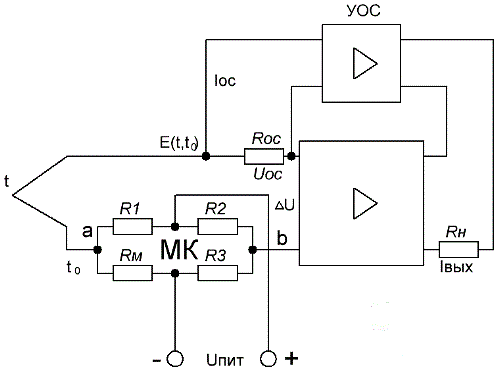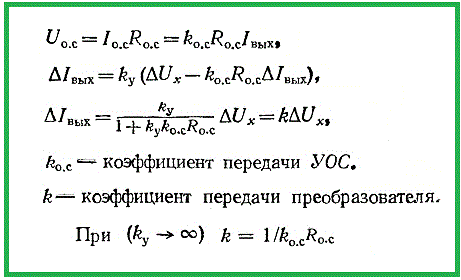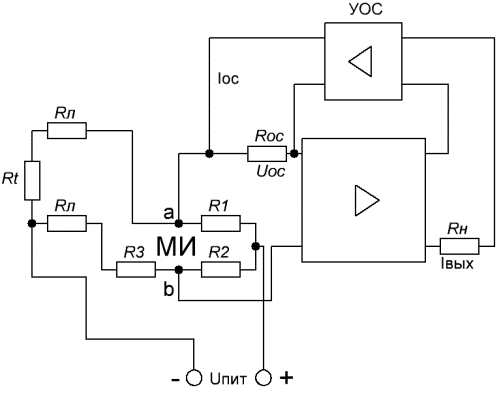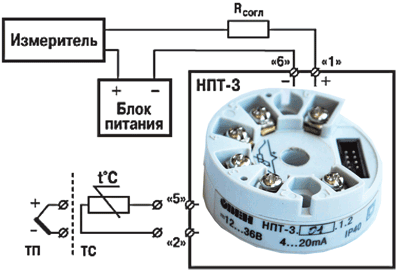Normalizing converters — purpose, device and principle of operation
For the purpose of primary processing of the signal from the output of a primary transducer, such as a resistance thermometer, a thermoelectric thermometer, or a measuring device that outputs an alternating current signal (for example, a pressure gauge), a normalizing transducer is used. Also called a measuring or intermediate converter.
The normalizing converter makes it possible to obtain a digestible DC signal from the available primary signal (for example, the thermoEMF E or the resistance value Rt can act as such a primary signal).
For example, let's look at how the measurement converter type PT-TP-68, designed to process a signal from a thermoelectric thermometer, works.


The figure below shows a simplified diagram of this converter, which allows obtaining a constant Iout within 5 mA of the thermoEMF E of the thermometer through the load resistance Rn, nominally 2.5 kOhm.The circuit contains: rectifier bridge MK, current output amplifier, feedback amplifier and feedback resistor.
The three resistors of the rectifier bridge are made of Manganese (special metal with low temperature coefficient of electrical resistance), and the fourth resistor is made of copper and is located closest to the terminals of the resistance thermometer.
The converter works according to a static self-compensation scheme: the voltage from the resistance thermometer is added to the voltage from the ends of the bridge (corrected in this way), then compared with the feedback voltage Uos. The resulting uncompensated signal is amplified by a current output amplifier.
Fed to the external circuit of the load resistor, the output current through the divider (not shown in the diagram) is fed to the feedback amplifier of the feedback device (consisting of a feedback amplifier and a feedback resistor). The input and output currents of the feedback amplifier (FBO) are proportional to kos. As a result, the feedback signal through the feedback resistor is created by the feedback current with the influence of the gain of the feedback amplifier.

Now consider an example of a normalizing converter designed to work resistance thermometer.
The figure below shows a simplified diagram of the normalizing converter of the PT-TS-68 model, which makes it possible to obtain a unified signal in the form of a current in the range from 0 to 5 mA by linearly converting the value of the resistance of the sensitive element.
The converter operates in accordance with a static circuit for automatic compensation.It includes: a measuring bridge, a current output amplifier and a negative feedback device (consisting of a feedback amplifier and a feedback resistor).
MI - the measuring bridge works here in a non-equilibrium mode, it converts the change in the resistance of the thermometer into a constant voltage, which is removed from the ends of the bridge and fed to an amplifier with a current output. Three bridge ballast resistors are made of manganin (small TKS). The bridge is powered by stabilized power supply… The thermometer itself is connected to the measuring bridge in a three-wire circuit.

OWEN NPT-3 Normalizing Converter
To automate technological processes, it is more convenient to obtain information about the measurement of direct current, especially if the further processing is carried out by information computers. For this reason, AC output devices use normalizing blocks that convert AC to a convenient DC signal for processing.
Thus, measuring devices with AC output can work with measuring units and measuring devices with DC inputs. But additional standardization blocks lead to an increase in errors and a decrease in reliability, this is especially important for nuclear power plants and thermal power plants, therefore, at the stage of creating automated systems for such important industries, it is necessary to immediately implement devices with an output that does not requires unnecessary transformations.
